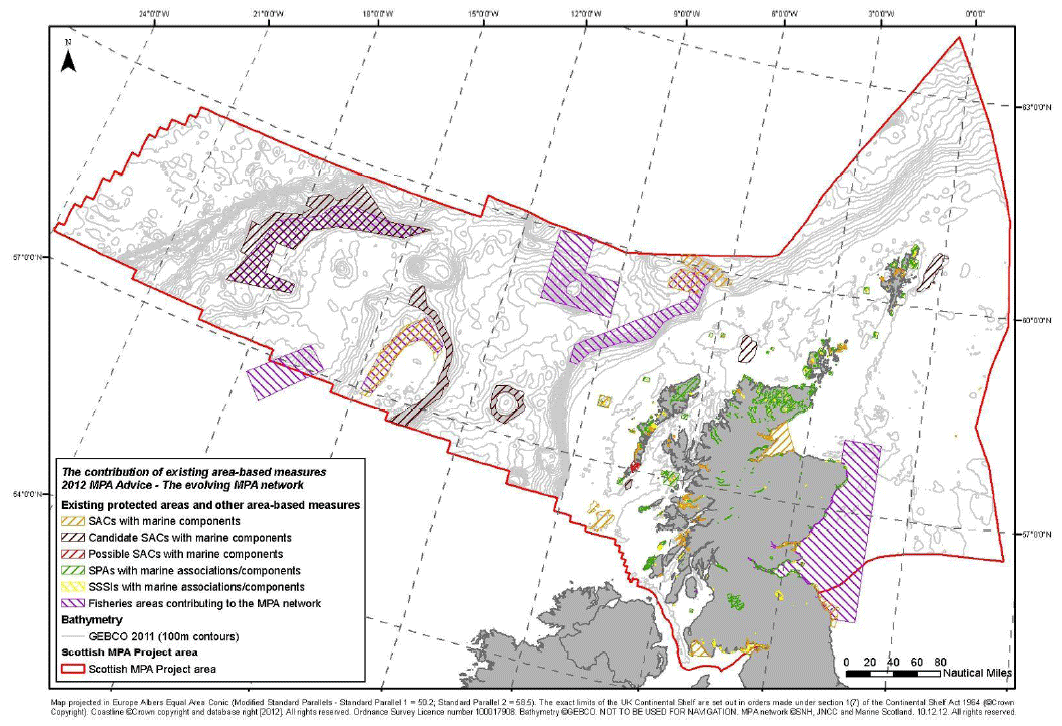Report to the Scottish Parliament on Progress to Identify a Scottish Network of Marine Protected Areas
This reports on which sites are currently included in the MPA network and outlines progress on Nature Conservation MPAs, Historic MPAs, and Demonstration and Research MPAs.
How the existing network protects Scotland's marine life
In accordance with Section 103 (3) (j) of the Marine (Scotland) Act and the equivalent provision under Section 124 (1) (a) of the Marine and Coastal Access Act, the report serves to update Parliament on the extent to which other and existing conservation measures contribute to a network of MPAs. The network of sites already designated contribute to the aim under Sections 79 (3) and 123 (3) of the respective Scotland and UK Acts:
a. That the network contributes to the conservation or improvement of the marine environment in the UK marine area,
b. That the features which are protected by the sites comprised in the network represent the range of features present in the UK marine area,
c. That the designation of sites comprised in the network reflects that the conservation of a feature may require designation of more than one site.
With additional Special Areas of Conservation, Special Protected Areas, Sites of Special Scientific Interest and Marine Protected Areas we are confident we can satisfy the requirements.
Existing protected areas along with other area-based conservation measures in Scotland's seas already make a significant contribution to the protection of our marine natural heritage and include, Special Areas of Conservation ( SAC), Special Protection Areas ( SPA), Sites of Special Scientific Interest ( SSSI) and fisheries management areas. The new Nature Conservation MPAs are being designed to build on this, thus maximising the possible conservation value from the network of protected areas.
Special Protection Areas ( SPA)
Special Protection Areas ( SPAs) are identified under the EU Wild Birds Directive. SPAs provide spatial protection for species listed in Annex I of the Directive as well as all migratory species. The significance of a site for migratory species is based on the proportion of the biogeographic population that depend on the habitat. For non-migratory species, the national population is used. Scotland's seas, especially the coastal waters, are hugely important for many groups of species such as the auks, northern gannet, Manx shearwater and black-legged kittiwake. For some, such as the Manx shearwater, storm petrel and great skua Scotland hosts a very significant part of the world population.
85 Special Protection Areas ( SPAs) support bird species that are dependent upon Scotland's marine environment (marine associations/components). Of these, 45 SPAs are either estuarine or truly coastal ( i.e. they contain intertidal habitats upon which one or more of the qualifying bird species depend) and these 45 are considered to contribute to the MPA network.
31 of our existing breeding colony SPAs for species such as guillemot, Atlantic puffin, northern gannet, northern fulmar and Manx shearwater have been extended into the marine environment to include the adjacent waters, important for behaviours such as preening, loafing and feeding.
SNH and JNCC are also currently assessing if data on the concentration of seabirds in the marine environment meet the selection guidelines for SPAs.
Special Areas of Conservation( SAC)
Special Areas of Conservation ( SACs) provide protection for a number of habitats and species of European Importance in Scotland's seas under the EU Habitats Directive. This includes reef habitats that make Scotland's marine environment special and distinctive such as the impressive biogenic reef formations of the cold water-coral lophelia pertusa in waters to the north and west of Scotland.
The Moray Firth SAC provides protection for our most northerly population of bottlenose dolphin and there are 14 SACs for grey and harbour seals for which Scotland is an important stronghold, which have also been designated. In total at present, there are 46 SACs and one more possible SAC in Scotland's Seas.
Sites of Special Scientific Interest ( SSSI)
At the national level, SNH has statutory powers to notify Sites of Special Scientific Interest ( SSSIs). SSSIs have been used to protect nationally important species, habitats and geological features in Scotland's seas down to mean low water spring mark (see Table 6.2).
There are 188 SSSIs contributing to the protection of habitats and species dependent upon Scotland's marine environment. Of these, 61 have some overlap with the Scottish marine protection area and are considered to contribute to the MPA network. The remainder are for bird interests associated with the marine environment.
A map illustrating the coverage of existing protection measures in Scottish waters is shown on the next page ( Figure 3), and a list of all the SACs, SPAs SSSIs and existing area based measures that contribute to the network are provided in annexes B to E.
River Basin Management Plans
By contributing to management of human induced pressures on water quality, a MPA network can contribute to the effectiveness of River Basin Management Plans and related action under the EU Water Framework Directive to protect and improve the water environment out to 3 nautical miles. In turn River Basin Management Plans are already contributing to the standards and objectives for protected areas. SEPA's register of protected areas and the on-going monitoring of these areas are further examples of how SEPA's work can contribute to a well managed MPA network.
Figure 4:Existing protected areas and other area-based measures contributing to the protection of Scotland's marine environment

Contact
There is a problem
Thanks for your feedback